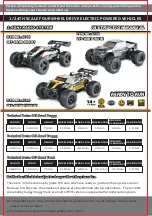
44
Example:
Set ball-head screw (A and B)
Tighten/loosen plastic grub screw (C)
Set camber more negatively:
Turn upper ball-head screw (A) to the right clockwise, and the lower ball-head screw (B) to the left counter-clockwise
(with small 2.5 mm-hexagon wrench (D) each).
Set camber more positively:
Turn upper ball-head screw (A) to the left counter-clockwise, and the lower ball-head screw (B) to the right clockwise
(with small 2.5 mm-hexagon wrench (D) each).
Twist the two ball-head screws (A) and (B) with the small 2.5 mm hexagon wrench (D) in opposite directions
(!) at all times and always by the same angle (e.g. a quarter turn to the left or right).
We recommend always changing the setting only by a quarter turn at a time and then reviewing the driving
behaviour.
The small hexagon hole of the ball-head screws (A) and (B) is only visible when looking right through the
large hexagon hole of the plastic grub screws (C).
Do not turn out the ball-head screws too far since the axle stub will no longer stick to the transverse link
otherwise.
Then check that the wheel suspension can be moved freely (the wheel can extend and deflect). If this is not the
case, loosen the plastic grub screws (C) with the large 5 mm-hexagon wrench (E); for this, turn it a small bit to the
left counter-clockwise.
If the axle stub is wobbly at the transverse links, turn the plastic grub screws (C) in to the right clockwise with the large
5 mm-hexagon wrench. Do not apply any force, as described, since the wheel suspension cannot move otherwise
and the wheel thus cannot extend or deflect.
Содержание 1547810
Страница 106: ...106 ...
Страница 107: ...107 ...
















































